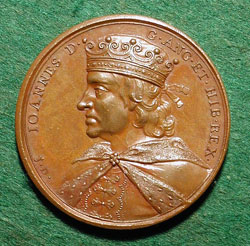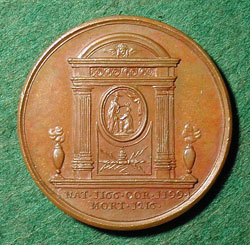

|
JOHN |
|
|
King John (1166-1216) (John Lackland) was King of England from 1199 to 1216. John was the youngest son of Henry II and Eleanor of Aquitaine. While his elder brother Richard I (The Lionheart) was absent on the Third Crusade, John conspired with Philip II of France to seize the throne of England. The plot was foiled, and John was banished and deprived of his estates. On his brother Richardís death John was invested as Duke of Normandy and crowned King of England by Pandulph, the Popeís Legate, the event alluded to on the reverse of this medal. In 1200 John married Isabella of Angouleme, precipitating a war with Philip II that resulted in the loss of Normandy and almost all of the other English possessions in France. In 1209 John was excommunicated by Pope Innocent III for refusing to accept Stephen Langton as Archbishop of Canterbury. John relented to papal authority in order to gain financial support from the church in his conflict with Philip II. His nephew and ally , Emperor Otto IV, was decisively defeated by Philip at the Battle of Bouvines and Johnís attack on La Rochelle floundered. On his return to England, John faced civil war and was compelled to sign the Magna Carta in 1215. His continued disregard of feudal rights, however, led to the first of the Baronís Wars. He was succeeded by his son, Henry III. (OíBrien) LINK to the Magna Carta (from historicaldocuments.com) |
|